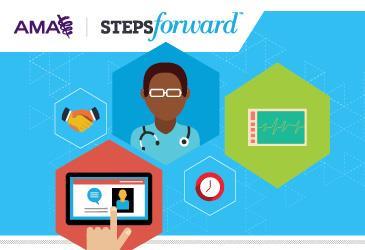Panel management, or population health management, equips physicians and their teams with techniques to monitor their patient populations so they can provide necessary preventive and chronic care to all patients, regardless of their visit frequency.

“Population health management, I think, is best used to identify opportunities and then you know where to put your efforts to develop different policies, or different patient flows or different visit frequencies to close those gaps and provide better care,” said Wisconsin internal medicine physician Richard Fossen, MD.
“Maybe it’s a provider who has a large diabetic population, or maybe it’s a provider who has a large female population—what’s important to them?” said Ann Gilbertson, a clinical quality innovation nurse at the same clinic as Dr. Fossen. “[Panel management] not only increased the satisfaction of the provider’s practice but it increased the quality of care for the patient.”
A free online module in the AMA’s STEPS Forward collection shows you how to implement panel management in your practice. Visit the module to get an in-depth look at what this looks like in practice—but first, read these six steps to panel management.
Develop a registry
A registry is a database with medical information about immunizations, cancer screenings and disease-specific lab results for the patients in your practice. You can search the registry to identify patients who are overdue for mammograms, cancer screenings, cholesterol blood tests or diabetic eye exams—or to identify patients who are missing this information and may need to come in for a visit. Some physicians have an electronic health record (EHR) system with this function or a separate registry program. If you have neither, the module includes information on how to start a simple registry.
Use a health maintenance template
If your EHR has a health maintenance screen, use the list of preventive and chronic care tests to prompt you and your staff to conduct screenings and tests or remind you to provide certain preventive care services.
Adopt clinical practice guidelines
Your practice should decide on clinical practice guidelines for preventive and chronic care services and use them to establish target levels for select health indicators.
Select and train staff to serve as panel managers
You’ll want to train nurses, medical assistants or reception staff in panel management. An initial time investment will lead to better care for your patients and improved efficiency in your practice. Get answers to training questions in the module.
Identify care gaps
A gap in care exists when a patient is overdue for a service that should be done periodically or when a patient is not meeting the goal range for a particular disease or condition, such as having an HbA1c greater than the recommended target. The module offers teaching exercises on how to identify these gaps.
Close care gaps through two methods
In the panel management world, you can close gaps through “in-reach” and “out-reach.” In-reach is for patients who are physically present in the office—for instance, a nurse may identify a care gap during a visit and discuss the necessary treatment with the patient. Out-reach is for patients who rarely come to the office or have fallen out of care and can be identified using the registry. The module includes information on having in-reach discussions and provides templates for out-reach letters and phone calls.
If you want to try panel management but feel like it may be overwhelming, start with the in-reach approach and use complementary tactics, such as pre-visit lab testing and pre-visit planning. Once you and your team feel ready, then you can move on to an out-reach approach.
Many more details about this process can be found in the module, including stories from real-life physicians such as Dr. Fossen. The module also includes information about how to get support for implementing this solution, and it offers continuing medical education credit. More than 25 modules are expected to be available in the AMA’s STEPS Forward collection by the end of the year.




